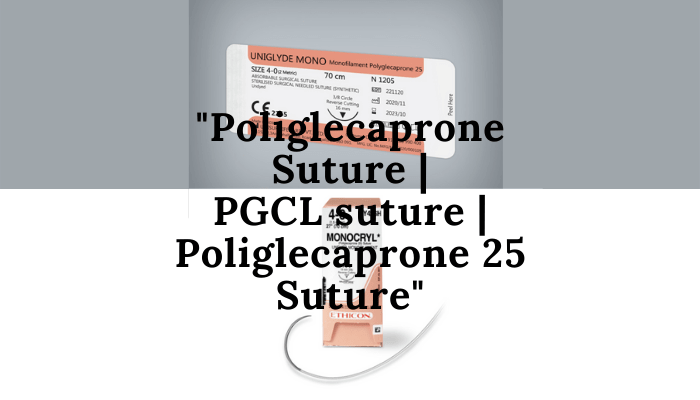Composition
Poliglecaprone / PGCL / Poliglecaprone 25 sutures are synthetic, monofilament, absorbable suture composed of glycolide and epsilon-caprolactone copolymer in the ratio of 75:25 (100/5 homopolymer). Due to the name of copolymers it is also called PGCL suture.
Characteristics
It is soft, extremely pliable with excellent handling properties, good knot security (but require 4-5 throws for a secure knot), smooth tie down and minimal tissue drag as being monofilament. Extra throws are required for continuous pattern. PGCL sutures are non-antigenic and non-pyrogenic in nature. It has more suture memory. Poliglecaprone suture is closer to nylon suture in consistency. It is a midterm absorbable suture material.
Absorption
Poliglecaprone 25 sutures are absorbed by means of hydrolysis (degraded into adipic acid and metabolized by the body) which ensures predictable and reliable absorption.
Tensile strength
It has high tensile strength among absorbable sutures and this allows selection of 1-2 size smaller than normal suture requires. It loses 40% tensile strength in 7 to 14 days, about 50% in 3-4 weeks and complete absorption takes place in 3 to 4 months (90 to 120 days). It has upto 60% higher tensile strength than gut sutures.
Indications
Poliglecaprone is used for general/soft tissue surgeries/intradermal layers/subcutaneous where prolonged support is not necessary. Poliglecaprone sutures are a reliable choice for scarless subcuticular / subdermal approximation like areas of the face. Subcuticular sutures must be placed as deep as possible to minimize erythema and induration. They can be used in gynaecological, obstetrical procedures and urology.
In subcuticular closure poliglecaprone suture results in significantly less reactive and smaller scars (less hypertrophic). They are ideal for subcuticular closure.
Contraindications
PGCL sutures are not suitable for use in areas of high tension, ophthalmic surgeries, microsurgeries, cardiovascular and neurological procedures. In orthopaedic procedures external immobilization may be needed to support. They are rarely used for percuatneous skin closure. It is not advisable to use poliglecaprone sutures in patients suffering from conditions that may delay wound healing, malnourished, elderly or debilitated patients. In places where extended approximation is required (fascia, tissues under stress) suture materials like polydioxanone or glycomer 631 can be used rather than PGCL sutures.
Use of poliglecaprone sutures are not indicated in patients with known sensitivities or allergies.
Tissue reaction
Adverse reactions like transient local irritation at wound site and foreign body response, erythema and induration during absorption process of subcuticular sutures can be seen. Due to foreign body response it may enhance an existing infection.
Poliglecaprone suture incites minimal tissue reaction (grade-1, slight reactivity) or virtually inert. It leads to ingrowth of fibrous connective tissue. It is less reactive than polyglactin 910.
Colour and Sizes
Poliglecaprone 25 is available in both dyed (violet) and undyed (clear or beige golden) forms. They are not coated like catgut but dyed.
Available in the different gauge sizes from 2 to 6-0 and lengths (45 mm to 75 mm) with swaged needles of different types, sizes and shapes (1/2, 3/8 circle, round body, reverse cutting, cutting, reverse cutting prime). It has good needle attachment strength. Available in tear open or peel open aluminium foil wrapped in paper pouch laminated with polyester laminated poly film.
Fig. Monocryl 4-0 from Ethicon – Poliglecaprone 25 suture – Undyed (*Ethicon are original inventors of PGCL sutures)
Fig. Petcryl mono (beige golden) – Undyed Poliglecaprone 25 sutures by Dolphin sutures
Handling and Storage
PGCL suture are also sterilized with ethylene oxide. Reprocessing or re-sterilization may compromise the tensile strength and may lead to suture dehiscence. Reuse may result into risk of contamination or cross infection. Care should be taken during handling to avoid crushing /crimping damage.
Recommended storage is at 10oC-35°C in a dry place. Shelf life is about 3 – 5 years from the date of manufacturing for poliglecaprone suture material.
FAQs
Polyglecaprone or PGCL is a mid-term absorbable synthetic monofilament suture made of glycolide and epsilon-caprolactone.
Monocryl suture is poliglecaprone suture which is an absorbable monofilament synthetic suture material. It is used for general/soft tissue surgeries/intradermal layers/subcutaneous where prolonged support is not necessary. Poliglecaprone sutures are a reliable choice for scarless subcuticular / subdermal approximation like areas of the face. Subcuticular sutures must be placed as deep as possible to minimize erythema and induration. They can be used in gynaecological, obstetrical procedures and urology.
Monocryl is Poliglecaprone which is synthetic monofilament absorbable suture made of a 100% copolymer of glycolide and epsilon-caprolactone.
Yes. Monocryl is a synthetic, absorbable monofilament suture.
Monocryl suture is completely absorbed by hydrolysis in 90 to 120 days.
No. Monocryl suture is synthetic absorbable monofilament suture and it doesn’t need removal.
